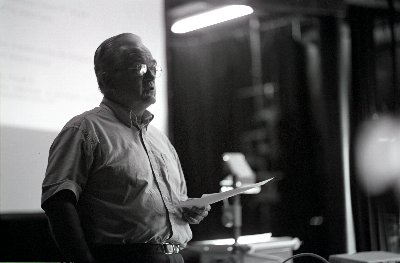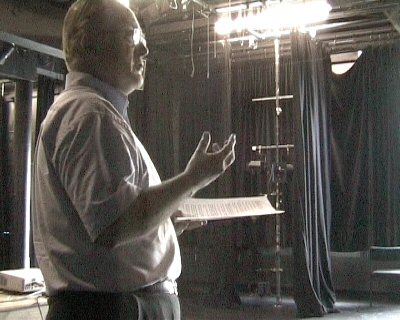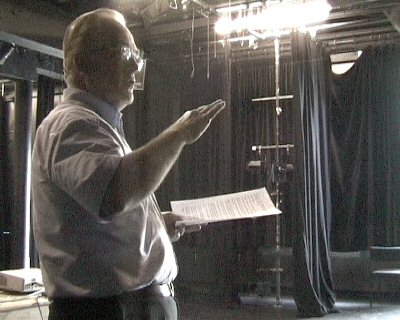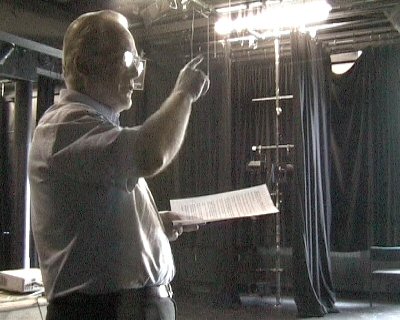 Virtuosity and Performance
Mastery issue, 2003/04
Virtuosity and Performance
Mastery issue, 2003/04
Virtual Virtuosity
Copyright © Mike Bridger 2003.
(No part of this text may be reproduced without the written permission of the author.)

This material was presented live at the Virtuosity and Performance Mastery symposium for postgraduate/research degree students and academic staff over two days by Performing Arts at Middlesex University on 31st May and 1st June 2003.
One of the qualities admired in virtuosic performance in any art is something akin to "superhuman-ness", whether manifested in extremes of power, scale, velocity, dexterity or some other characteristic, depending on the art form or genre involved. Inevitably, such qualities can easily shade into the "machine-like", which instinctively seems to be a less desirable quality, and in this short presentation some examples of this in electronic music are considered in the context of speculation about an aesthetics of the artificial. There is, of course, a fundamental paradox here, since human expressivity and mechanically created art are more likely to be in opposition than a state of synergy. However, in the burgeoning electronic media of the present day world, it is apposite to speculate about the aesthetic principles of these media and about what might constitute virtuosity in them. I should explain that in earlier research I have looked into audience response to electronic music, and I am currently attempting to outline some fundamental principles and issues in "cyberaesthetics" - the aesthetics of artificial, possibly computer-generated sound and image referred to above.
Starting with a definition: according to the Collins English Dictionary a "virtuoso" is "(1) a consummate master of musical technique and artistry or (2) a person who has a masterly or dazzling skill or technique in any field of activity". The use of the word as a modifier (as in "virtuoso performance") is also noted. From this definition it seems that the word and concept originated in the field of music and then acquired broader connotations.
Each of these two definitions embraces concepts that are relevant in the particular perspective I am exploring. First of all, the notions of virtuosity and mastery are coupled together in the definitions, as they are in the title of our symposium, and a crucial point I hope to make is that the concept of virtuosity is contingent on prior, codified establishment of techniques that are capable of being mastered. Mastery implies pre-existing, accepted codes or conventions that underpin a genre, are utilised by performers and understood by audiences, and can be judged to be mastered (or not); on this basis qualities of virtuosity can be judged.

Moving to consider electronic music - of course, a consequence of the short timescale of its existence, and the radical departure from earlier practice that it represents, is that it inevitably lacks the accumulated and widely accepted conventions, techniques and grammars that characterise other musics. This is not to say that electronic art does not have techniques and conventions, but I think it is true to say that the measures by which one would judge that a particular example has achieved mastery are more fluid, open to subjective judgement and debate than in most other genres of music. Further insights from the dictionary include the words "and artistry" in the first definition ("a consummate master of musical technique and artistry"), implying that a mere display of astounding technique does not in itself constitute virtuosity. This is not promising for electronic music, but this is counterbalanced by the fact that in the second definition the words "or dazzling" conjure up a dimension that certainly can apply to the field of electronic music that is my particular interest.
Of course, dictionary definitions should not be treated as sacrosanct tablets of stone, and I am perhaps in danger of making too heavy weather of getting off the launch-pad of this line of thought, but in my mind the notion of the virtuoso is so much tied up with the image of a Paganini-like phenomenon, with a human, flesh and blood, presence and pyrotechnic display that appears to transcend what is possible for lesser mortals, that the use of the term virtuoso in the world of electronic music seems to require justification or at least some caution. After all, much electronic music performance takes place without any overt human presence or involvement, to the extent that the absence of a performer can be in itself a sort of inverse virtuosity.

In a longer exploration of this topic, it would be interesting to consider examples of mechanically produced acoustic music - the astonishingly complex compositions for player-piano by Conlon Nancarrow, for instance, and fairground organs that employ punched cards and can achieve levels of precision and rapid articulation that exceed human capabilities. But my main interest here is in electronic music, and my comments will focus on three short examples:
Example 1 - JS Bach - Brandenburg Concerto IV/iii / Walter Carlos
When this recording was issued in 1968 it was certainly regarded as a work of some virtuosity. What is remarkable, I think, is its sense of effortless exuberance, which belies the fact that it was created by painstaking multi-tracking. It did, of course, annoy people on both sides of the debate about electronic music - for the hard-line protagonist of electronic music as a new art form it was a shamelessly commercial misuse of the developing technology, while for musicians involved in the authentic performance movement that was just picking up speed it was hard to take seriously. However, Glenn Gould, ever on the look out for controversy, hailed it as "the finest performance of any of the Brandenburgs - live, canned or intuited - I've ever heard" (sleeve note of CBS 63656).
Example 2 - Kontakte by Karlheinz Stockhausen
I was pleased to discover that Paul Griffiths wrote of Kontakte: "Stockhausen here displays his virtuosity [my emphasis] in creating sound of unprecedented richness" (Griffiths 1979 p.43). About a year ago I attended a performance of Kontakte in its purely electronic version at the Barbican. This was certainly an occasion for the display of enormous virtuosity; Stockhausen himself presided at the sound projection console and his presence and involvement went a long way to counteract the alienating sense of non-humanness that can afflict electronic music performance. I had gone to this concert apprehensive that my encounter with one of the classics of early electronic music may prove an arid experience but it was exhilarating, pyrotechnic and totally absorbing, renewing my optimism that electronic music really does have a promising future.

Example 3 - Prelude XI for Magnetic Tape by Ilhan Mimaroglu.
I should explain that all sounds in this piece were derived from recordings of a rubber band, with the further restriction that use of techniques other than those of recording and tape manipulation was kept to a minimum. As in so many other contexts - the successful overcoming of restrictions, even if arbitrary in nature, does provide at least the possibility of achieving a sense of the virtuosic.
It is perhaps self-evident that a prerequisite for virtuosity is that the performance task must involve difficulty - a virtuoso performance of a very easy piece is almost a contradiction in terms. A hundred or so years ago, Busoni dreamed of music released from the restrictions of acoustic instruments that held it in chains (see Busoni, 1911), and it is true that electronic music has the potential to exceed the possibilities of acoustic music in every respect; it can be louder, faster, longer, denser, higher, lower… - the extremes of any parameter of musical sound are available. But the dilemma is that all of this can be achieved without any detectable commensurate increase in the skill or human effort required. The concept of virtuosity, therefore, remains problematic in this genre. If the medium itself does not itself reveal a grammar of difficulty then one solution is for composers to impose their own, as Mimaroglu did with his adoption of a rubber band as a sound source and his rejection of studio techniques other than those intrinsic to the tape medium itself.
So, in the current state of art and technology in electronic music - where the nature of the technical and artistic challenge that is being overcome is manifest to the audience there is no question that the sense of some sort of virtuosity is part of the aesthetic appeal. However, in the defining context of the "Paganini phenomenon" referred to above, the virtuosity of electronic music seems to be of a different order to that commonly understood in the realm of western acoustic music. It will be interesting to see in the next few years whether the appeal of virtuosity is strong enough to stimulate the development of a new genre of electronic music and associated instruments that re-establishes the necessary conditions for virtuosic performance in this idiom.
Putting it slightly differently, and re-introducing the other terms of the symposium title - virtuosity in electronic music will only become possible in the sense that it is evident in other genres if or when the conditions for performance mastery develop.
Bibliography
Busoni, F. (1911). Sketch of a new aesthetic of music. Schirmer (reprinted Dover, 1962).
Griffiths, P. (1979). A guide to electronic music. Thames and Hudson.
Discography
Bach, JS / Carlos, W. (1969). Brandenburg Concerto II (iii). CBS 63656
Mimaroglu, I (1967). Prelude XI. Turnabout TV 34177S
Stockhausen, K. (1960). Kontakte. Caprice CAP 21642
Photographs copyright © 2003 John Robinson.
Background image Lakeside building, Trent Park campus of Middlesex University.
Page last updated 30th August 2004.
